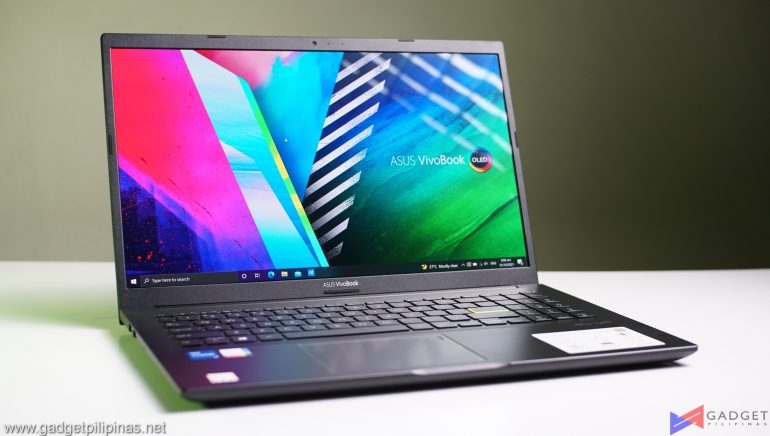Introduction
ASUS’ VivoBook series has been the brand’s budget-level laptop that rivals other brands’ entry-level laptops such as Acer’s Aspire series and Lenovo’s Ideapad line. What these laptops have in common is their build quality and specs with most sporting either Intel’s Core i3 to i5 models or AMD’s Ryzen 3 to Ryzen 5 CPUs. Apart from either having gimped 4GB memory or a mechanical hard drive to lower the overall price, there are not many factors that would make these budget laptops shine and attract customers. Going back to the VivoBook series, ASUS recently launched your typical budget-oriented laptop with a feature that makes it stand out in its league. The ASUS VivoBook 15 OLED as the name suggests, has a 15.6″ 1920x1080p OLED display that’s a first for laptops priced under Php 50,000. Packed in either Intel or Ryzen flavors, the ASUS Vivobook 15 OLED is an entry-level laptop sporting 8GB DDR4 RAM and a 512GB PCI-E SSD across all configurations and is priced for as low as 34,9995 for the base model. Let’s take a deeper dive at the VivoBook 15 OLED to see what compromises Asus had to make to keep the laptop competitively priced while introducing a premium feature that’s previously only found on flagship ultrabooks.
ASUS VivoBook 15 OLED K513 Specs, Price, and Configuration
| ASUS Vivobook OLED 15 Configurations | K513EA-L11402T | K513EA-L11108TS | M513-L1297T | M513UA-L1301TS |
| Processor | Intel Core i3 1115G4 | Intel Core i5 1135G7 | AMD Ryzen 5 5500U | AMD Ryzen 7 5700U |
| Memory | 8GB DDR4 RAM | 8GB DDR4 RAM | 8GB DDR4 RAM | 8GB DDR4 RAM |
| Storage | 512GB PCIEx4 SSD | 512GB PCIEx4 SSD | 512GB PCIEx4 SSD | 512GB PCIEx4 SSD |
| Graphics | Intel UHD Graphics | Intel Iris Xe Graphics | AMD Radeon Graphics | AMD Radeon Graphics |
| Display | 15.6″ 1920×1080 OLED | 15.6″ 1920×1080 OLED | 15.6″ 1920×1080 OLED | 15.6″ 1920×1080 OLED |
| Price | 34,995 | 49,995 | 42,995 | 49,995 |
Unlike most laptops sporting confusing configurations, the VivoBook 15 OLED only has four variants with the main difference being the processor for each variant. All of the Vivobook 15 OLED sports the standard 4+4GB DDR4 memory and 512GB PCI-E Gen 4 SSD. The base model starts at Php 34,995 and is equipped with an Intel Core i3 1115G4 CPU making it the cheapest OLED laptop in the market. For an additional Php 8,000, you can get the AMD Ryzen 5 5500U variant and at Php 49,995 users can decide to go for either the Core i5 1135G7 or the Ryzen 7 5700U. Our specific model for benchmark in this review is the ASUS VivoBook 15 OLED K513EA-L11108TS with the Core i5 1135G7 processor.
ASUS VivoBook 15 OLED Unboxing and First Impressions
- ASUS VivoBook 15 OLED K513E Review 124
- ASUS VivoBook 15 OLED K513E Review 124
- ASUS VivoBook 15 OLED K513E Review 118
- ASUS VivoBook 15 OLED K513E Review 118
The laptop comes in a standard laptop box packaging with only the name and the brand name printed in the front and the standard safety marking and model SKU at back. Unlike higher-priced laptops, the ASUS Vivobook doesn’t have any internal packaging aside from the brown laptop box itself.
- ASUS VivoBook 15 OLED K513E Review 112
- ASUS VivoBook 15 OLED K513E Review 112
- ASUS VivoBook 15 OLED K513E Review 002
- ASUS VivoBook 15 OLED K513E Review 002
The laptop lid is metal and coated in a matte finish that’s still frankly a fingerprint magnet denoting its “cheap” or standard quality. ASUS continues to use its off-center logo placement even in their budget line as represented by the ASUS VivoBook logo on the VivoBook OLED 15. Instead of rubber feet that would run across the length of the laptop, ASUS used the aged circular rubber feet that also act as a small riser for airflow management.
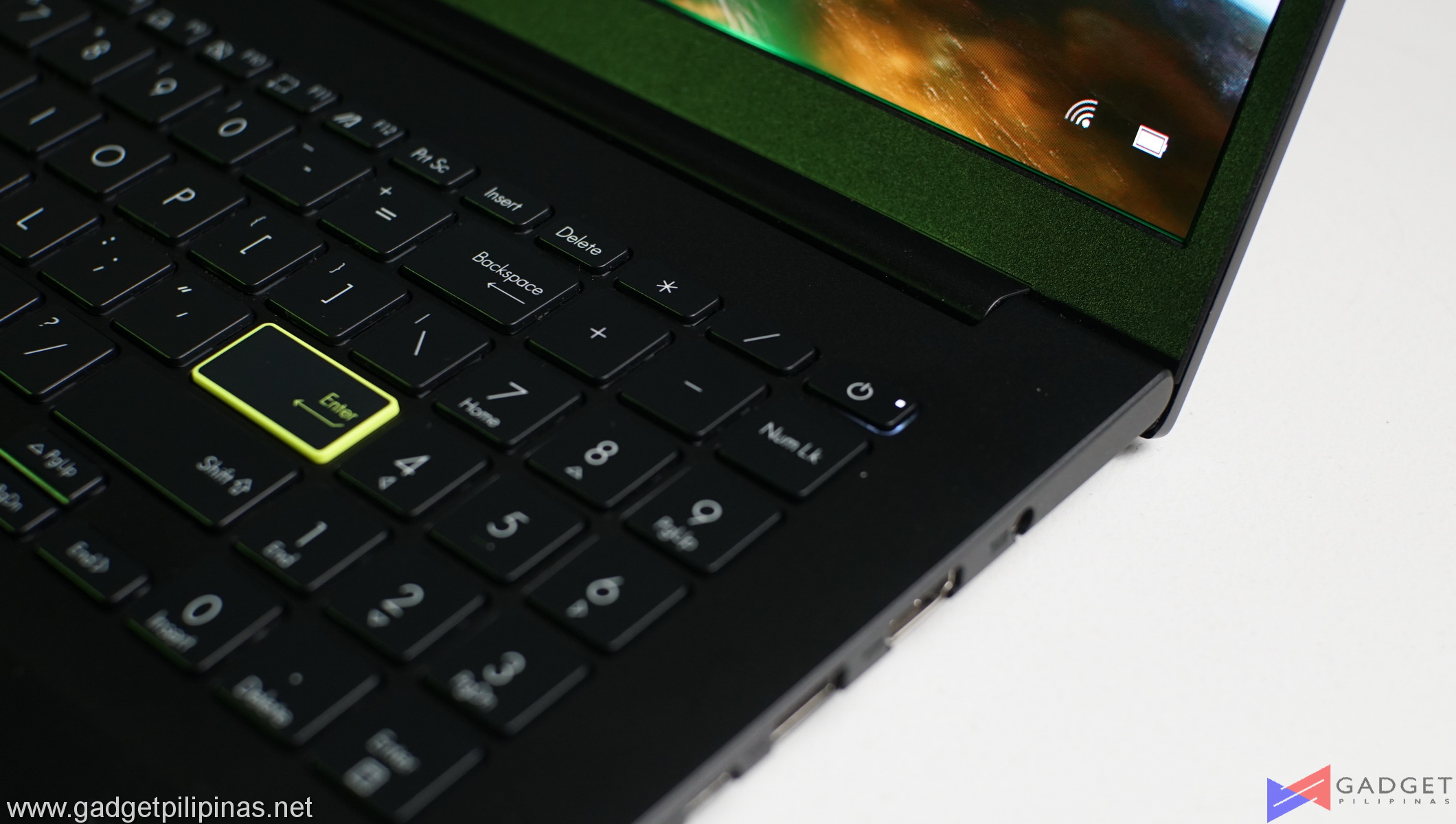 The ASUS Vivobook OLED 15 has a full-sized hinge that bends up to almost 120-degrees. The hinge slightly follows the Ergolift design on Zenbook laptops albeit it only hides part of the laptop chin and doesn’t elevate the keyboard area.
The ASUS Vivobook OLED 15 has a full-sized hinge that bends up to almost 120-degrees. The hinge slightly follows the Ergolift design on Zenbook laptops albeit it only hides part of the laptop chin and doesn’t elevate the keyboard area.
- ASUS VivoBook 15 OLED K513E Review 050
- ASUS VivoBook 15 OLED K513E Review 050
- ASUS VivoBook 15 OLED K513E Review 024
- ASUS VivoBook 15 OLED K513E Review 024
Ports selection on the VivoBook OLED 15 is generous with connectivity as it has one USB 3.2 Gen 1 Type-A port, one USB 3.2 Gen 1 Type-C port, one HDMI port, a headphone jack, and a MicroSD 4.0 card reader on the right side. The left side sports two USB 2.0 Type-A ports. With its thickness of 17.9mm, ASUS could’ve easily added an ethernet port to complete the IO and maximize the laptop’s form factor.
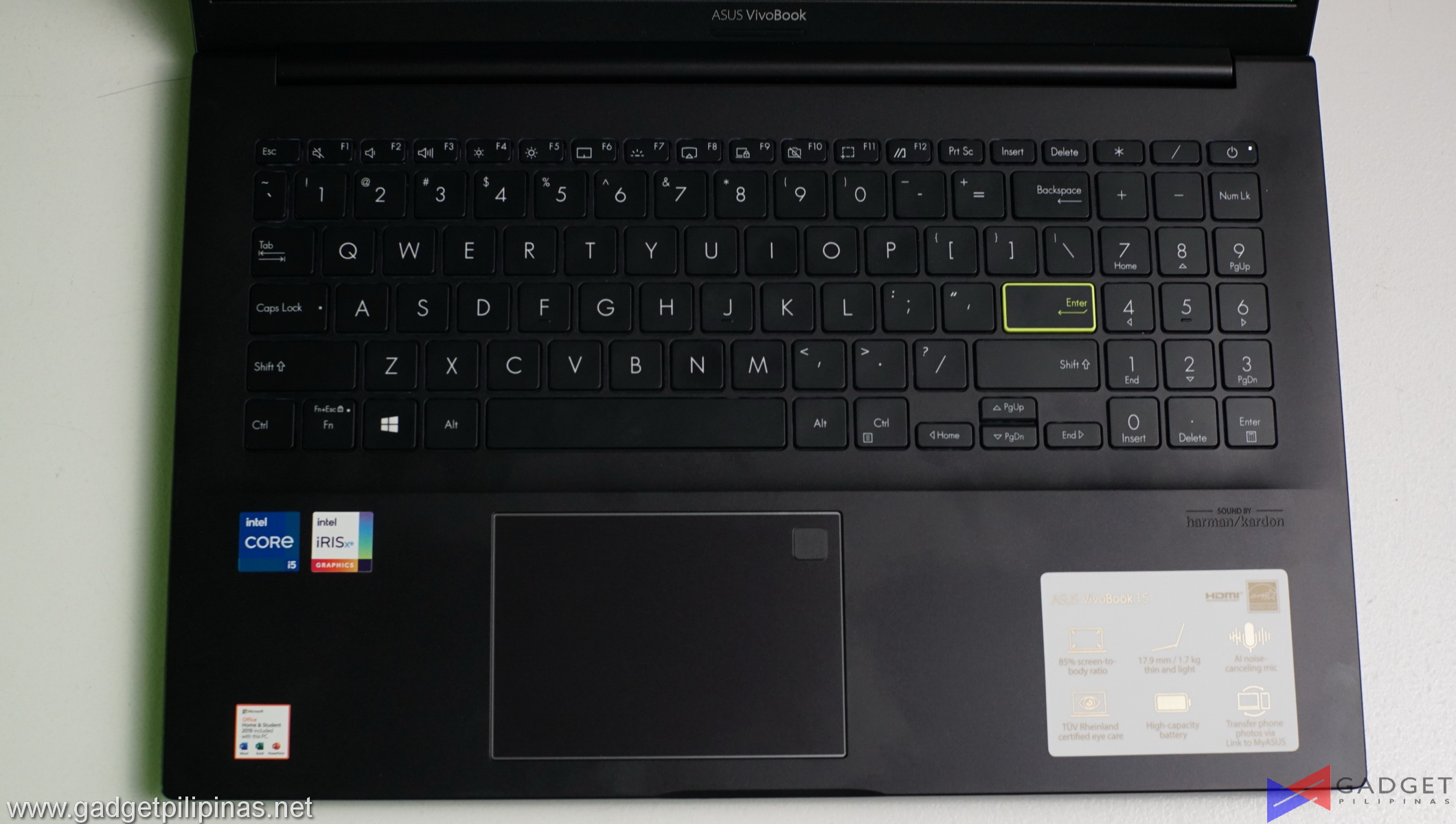
A 15.6″ form factor feels like a blast from the past as the market has trended towards 14″ inch ultrabooks as well as taller ratio displays. While the 15.6″ Vivobook OLED 15″ suffers in portability due to its size, it does have its perks like a larger sized keyboard area and trackpad eliminating the immediate need for a USB keyboard or mouse especially if you have larger hands.
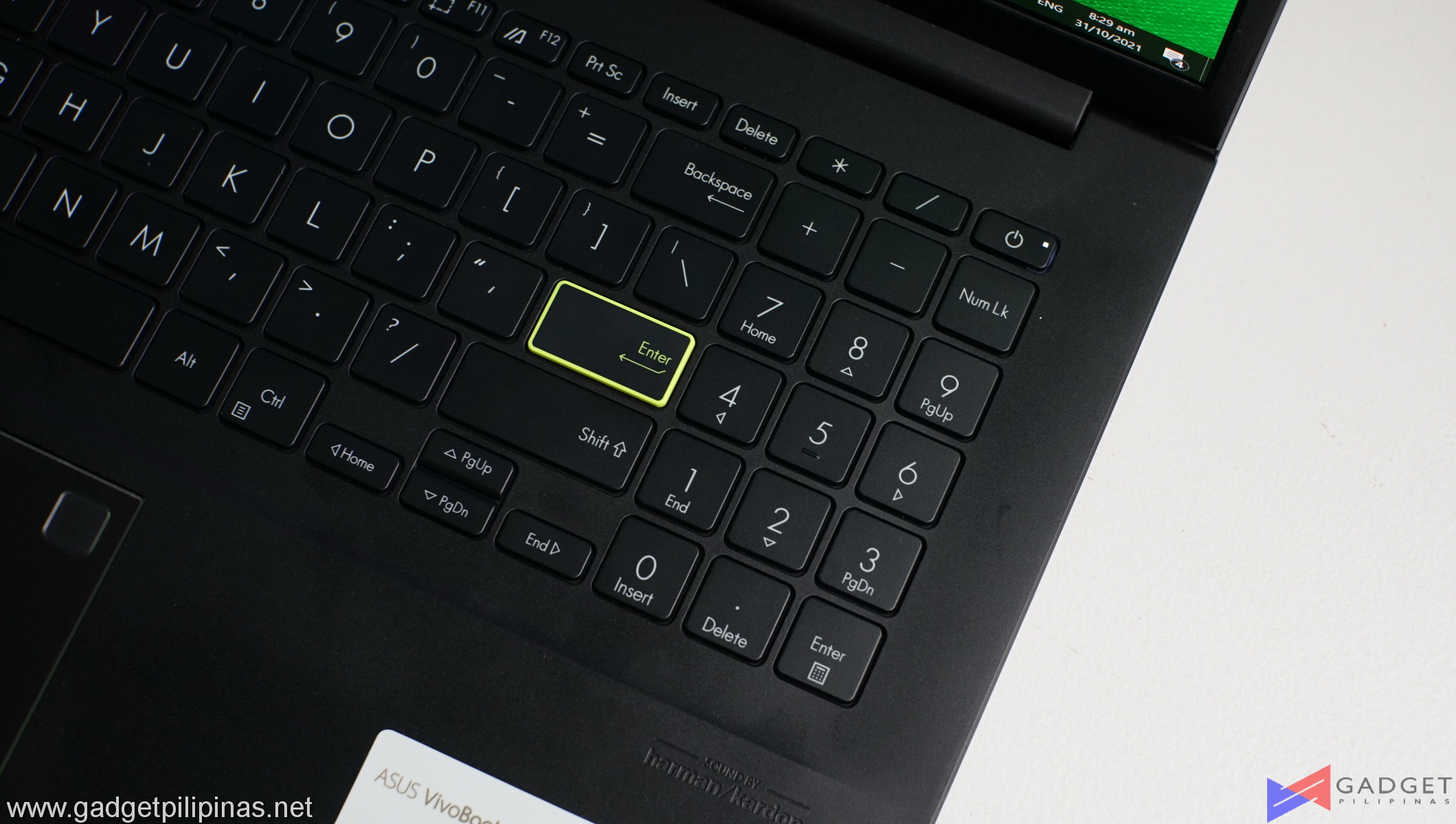 As soon as I tried typing on the VivoBook OLED 15, I keep on missing the shift, enter and backspace keys as I almost always hit the numpad area even if I am just resting my fingers. The lack of proper spacing between the general keyboard area and the numpad area makes it hard to transition from a laptop with no numpad or even in a full-sized keyboard.
As soon as I tried typing on the VivoBook OLED 15, I keep on missing the shift, enter and backspace keys as I almost always hit the numpad area even if I am just resting my fingers. The lack of proper spacing between the general keyboard area and the numpad area makes it hard to transition from a laptop with no numpad or even in a full-sized keyboard.
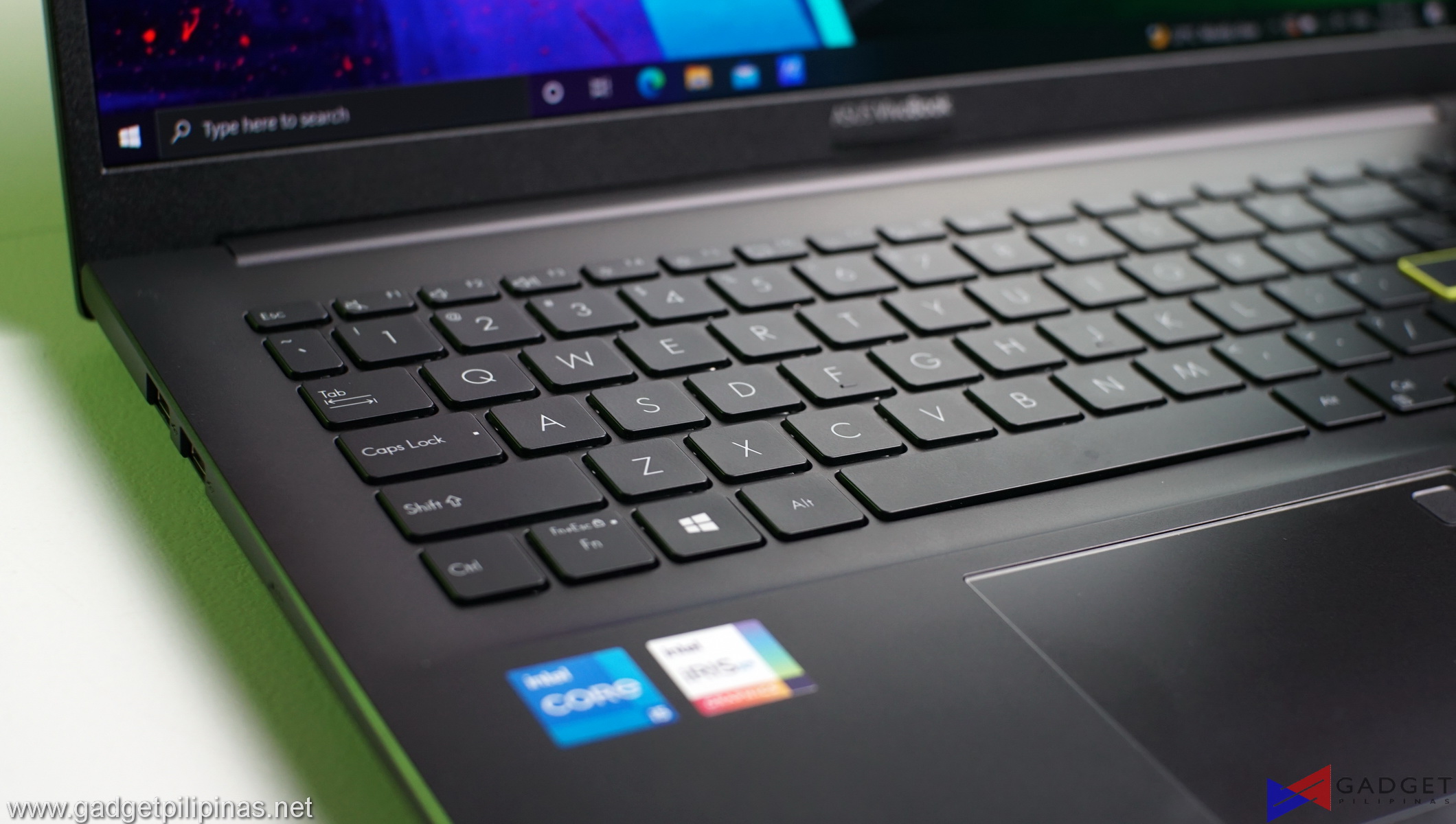 Numpad typos aside, the typing experience on the ASUS VivoBook OLED 15 K513EA is decent enough, especially for a budget-oriented laptop. The 1.4mm key travel doesn’t feel too short nor too long. The keycaps are not as wobbly
Numpad typos aside, the typing experience on the ASUS VivoBook OLED 15 K513EA is decent enough, especially for a budget-oriented laptop. The 1.4mm key travel doesn’t feel too short nor too long. The keycaps are not as wobbly
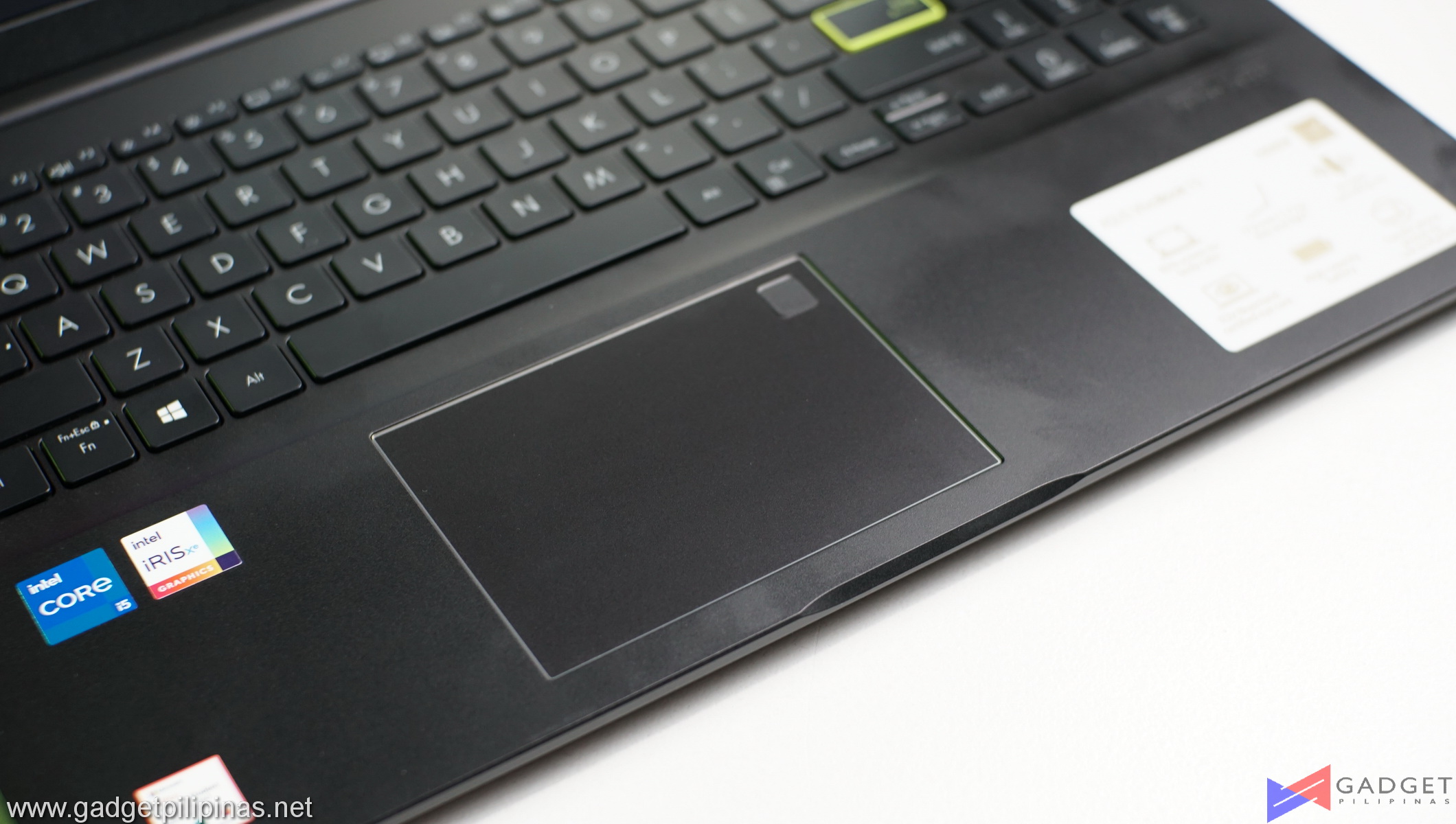 Tracking is fairly standard with an almost glossy texture. The fingerprint reader is located at the top right corner of the laptop effectively losing surface area for the trackpad. Clicks are stiff enough to convince me to use a mouse instead despite the fairly large trackpad.
Tracking is fairly standard with an almost glossy texture. The fingerprint reader is located at the top right corner of the laptop effectively losing surface area for the trackpad. Clicks are stiff enough to convince me to use a mouse instead despite the fairly large trackpad.
ASUS VivoBook 15 OLED Display and Camera
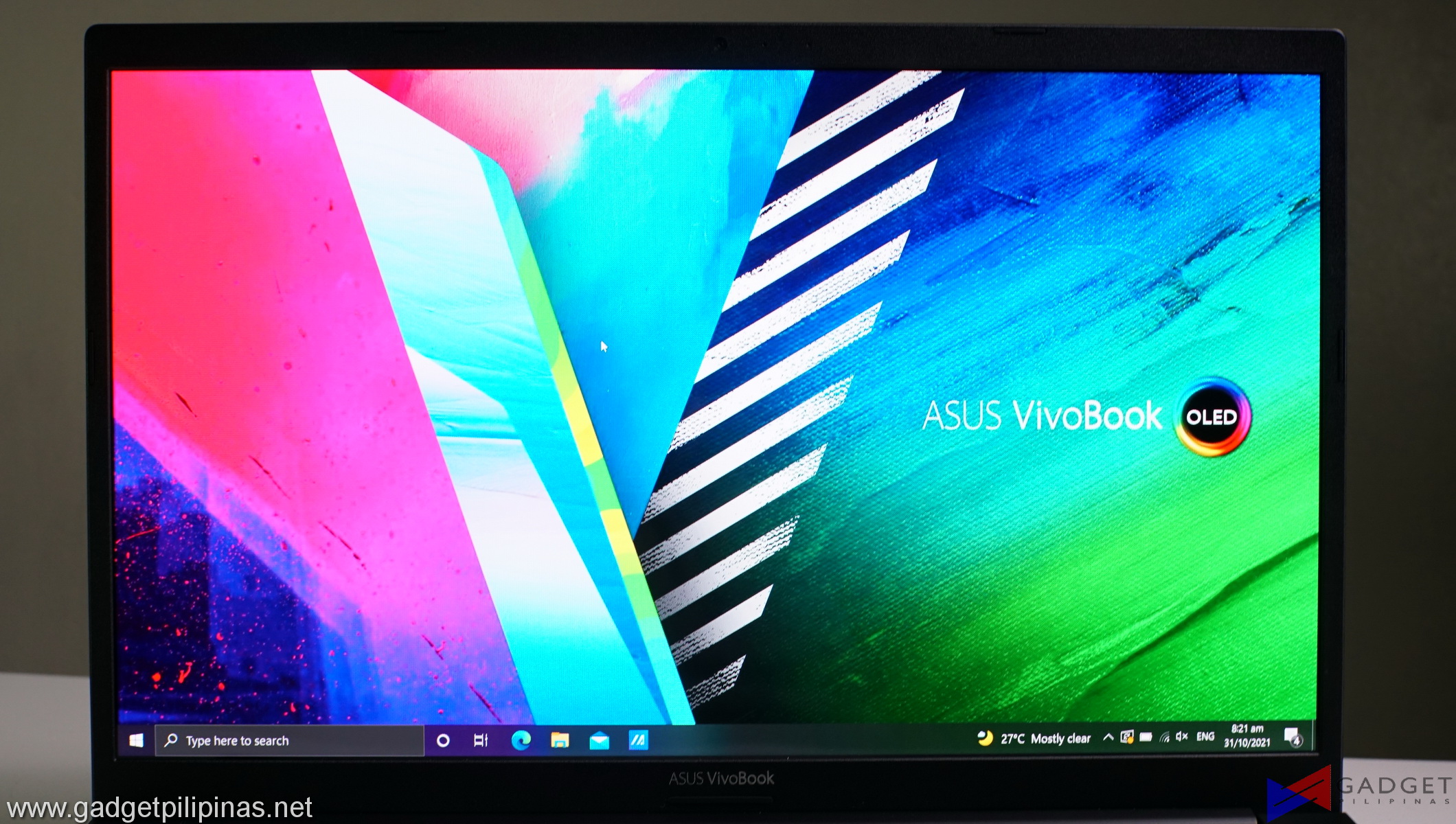 Having an OLED display on a laptop is one of the most game-changing experiences you can have for a mobile device. If you’re impressed by the switch from TN to IPS for most of your devices then you’ll be stunned once you try out an OLED display, especially with a large footprint like the ASUS VivoBook 15 OLED. The 1920x1080p resolution is frankly the weakest link in the display specifications as you don’t get to enjoy sharper images and videos due to its 15.6″ widescreen whereas most laptops even smaller 13″ ultrabooks have nicer QHD displays that make images and videos pop despite not having the OLED advantage.
Having an OLED display on a laptop is one of the most game-changing experiences you can have for a mobile device. If you’re impressed by the switch from TN to IPS for most of your devices then you’ll be stunned once you try out an OLED display, especially with a large footprint like the ASUS VivoBook 15 OLED. The 1920x1080p resolution is frankly the weakest link in the display specifications as you don’t get to enjoy sharper images and videos due to its 15.6″ widescreen whereas most laptops even smaller 13″ ultrabooks have nicer QHD displays that make images and videos pop despite not having the OLED advantage.
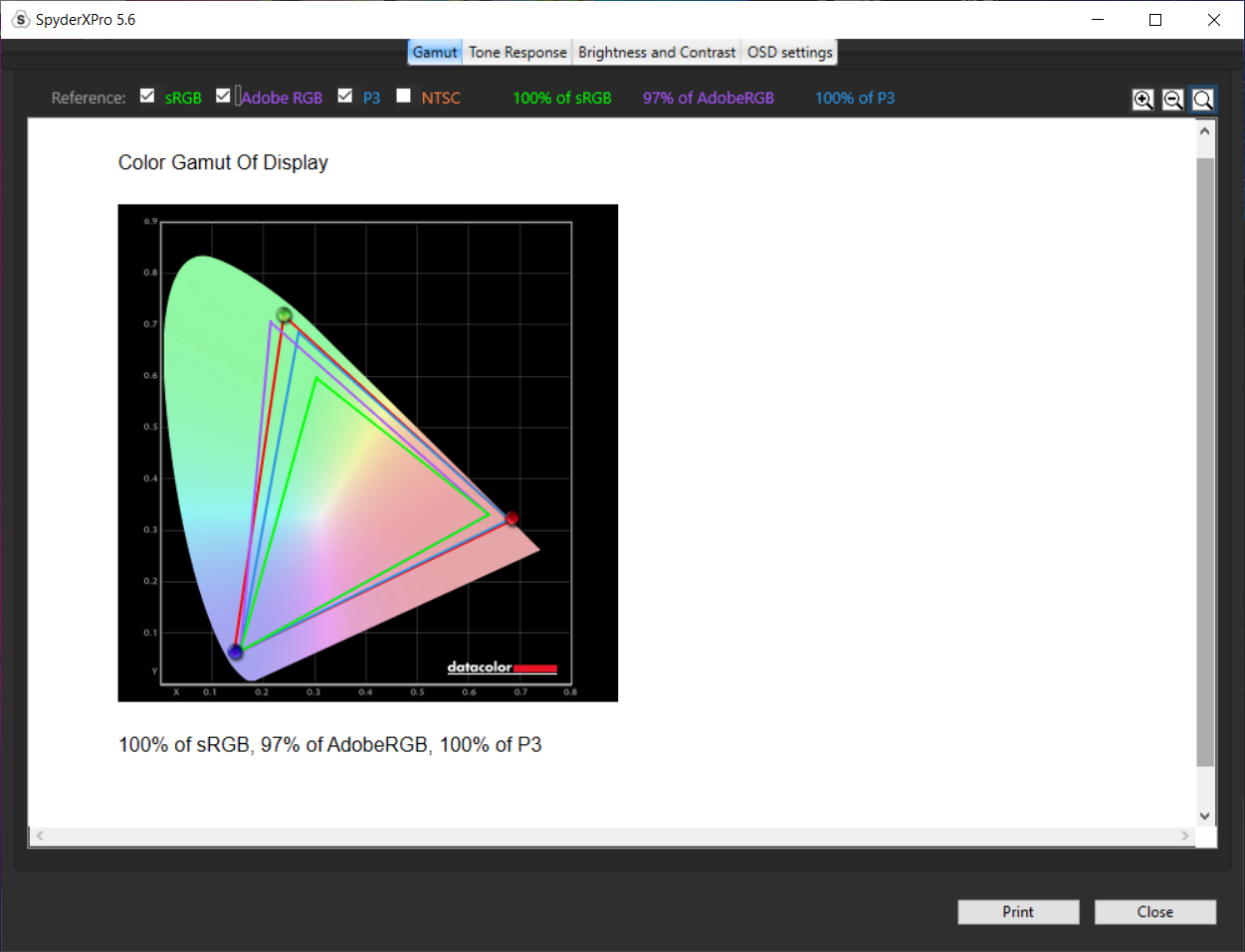 The VivoBook OLED 15 passes with ease our SpyderXPro Display Analysis Tool scoring 100% sRGB rating, 97% AdobeRGB, and 100% DCI-P3. The ASUS VivoBook OLED 15 is great for any professional color-related world
The VivoBook OLED 15 passes with ease our SpyderXPro Display Analysis Tool scoring 100% sRGB rating, 97% AdobeRGB, and 100% DCI-P3. The ASUS VivoBook OLED 15 is great for any professional color-related world
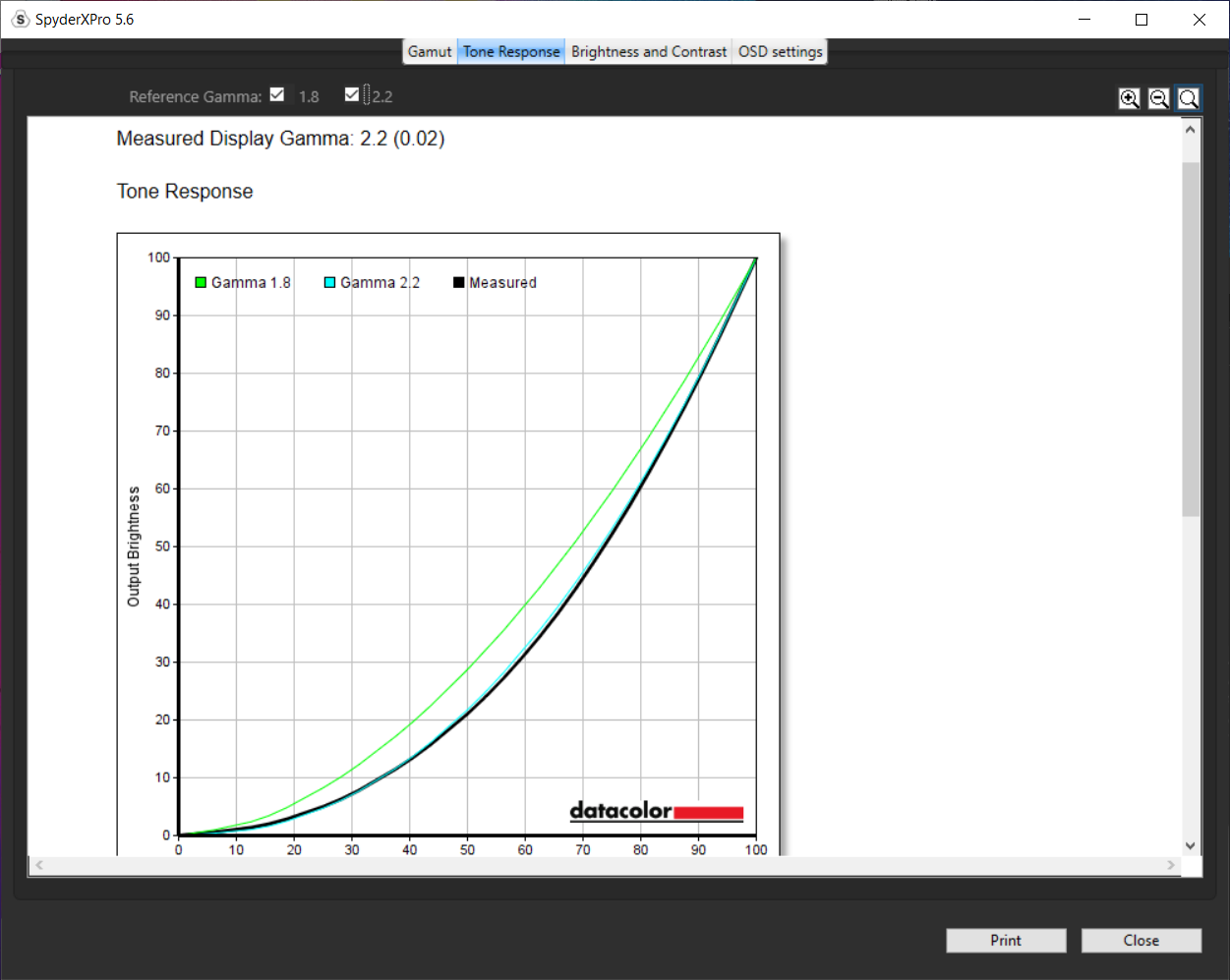 Gamma values are also impressive with only a DeltaE of 0.02. It basically means the VivoBook OLED 15 produces optimal colors with more depth and realism.
Gamma values are also impressive with only a DeltaE of 0.02. It basically means the VivoBook OLED 15 produces optimal colors with more depth and realism. 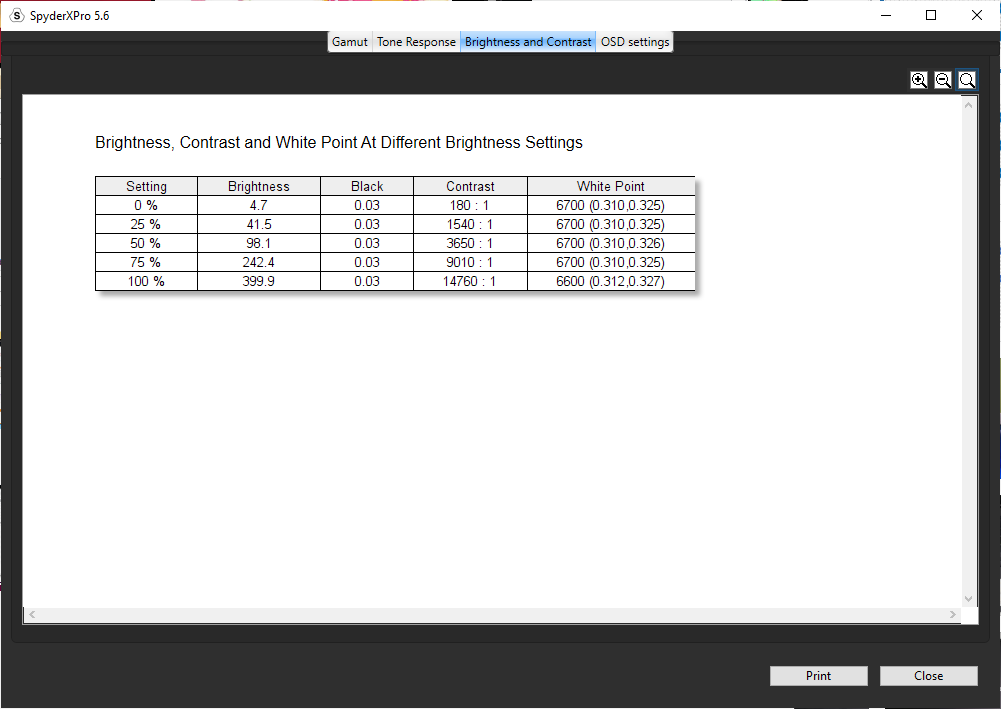 Following the rest of our display test results, the VivoBook OLED 15 has a near 6600 color temp which is very much close to the 6500K standard. The only thing that’s off with the display is its very uneven brightness setting distribution as 50% brightness setting only outputs 98.1 nits while 75% settings output 242 nits out of the max rated 400 nits at 100 percent. Do note that having a higher brightness setting results in higher power consumption, therefore, reducing your laptop’s battery life.
Following the rest of our display test results, the VivoBook OLED 15 has a near 6600 color temp which is very much close to the 6500K standard. The only thing that’s off with the display is its very uneven brightness setting distribution as 50% brightness setting only outputs 98.1 nits while 75% settings output 242 nits out of the max rated 400 nits at 100 percent. Do note that having a higher brightness setting results in higher power consumption, therefore, reducing your laptop’s battery life.
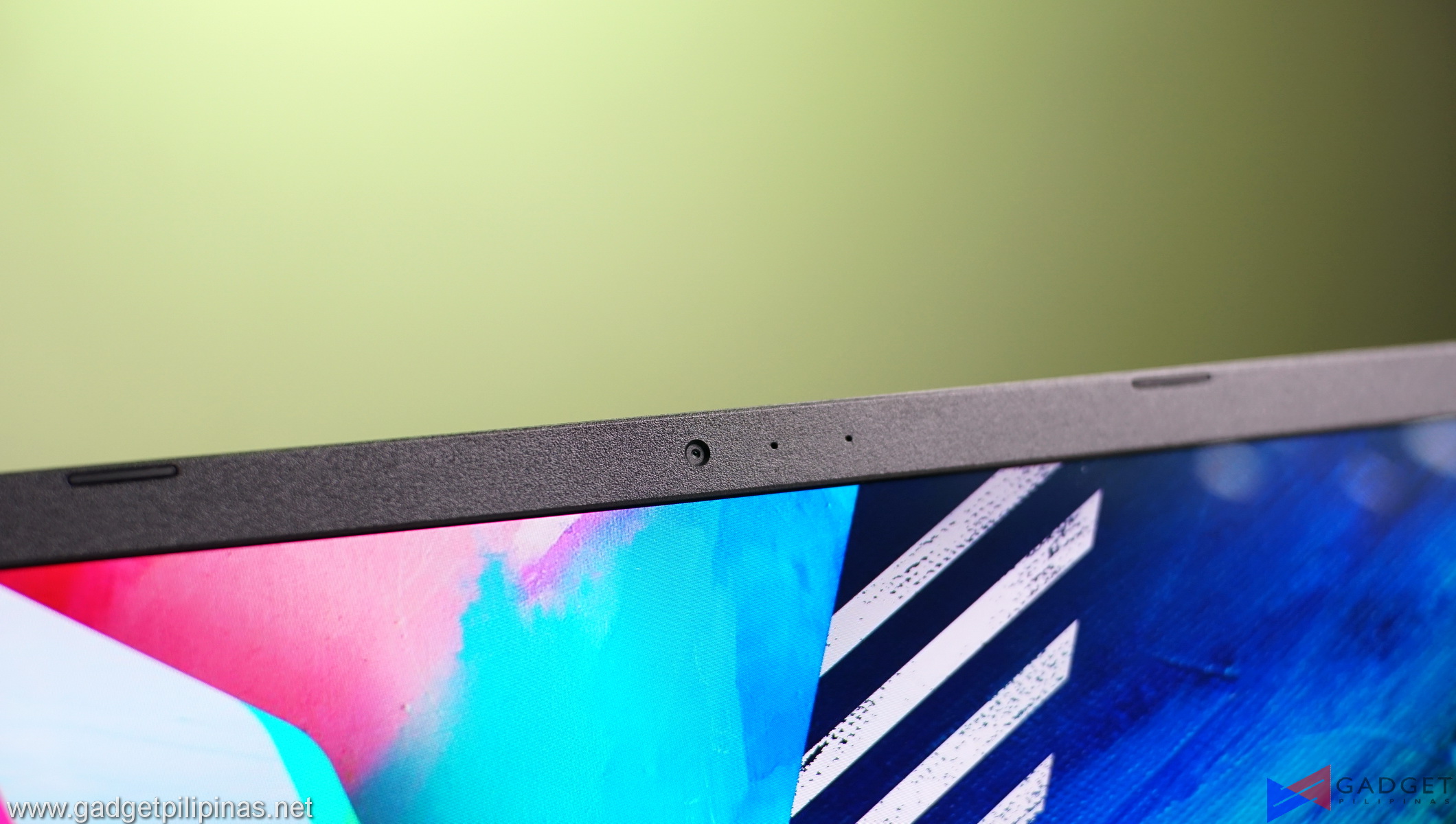 The ASUS VivoBook OLED 15 comes with your standard laptop webcam with no privacy shutter.
The ASUS VivoBook OLED 15 comes with your standard laptop webcam with no privacy shutter.

While the Vivobook OLED 15’s display is one of the best, its webcam definitely tops the list of the worst webcams we’ve tested. We strictly recommend getting a third-party camera even budget ones under Php 1,000 as those will still have a way better output than the one installed on the Vivobook OLED 15.
ASUS VivoBook 15 OLED Synthetic Benchmarks
We benchmarked the ASUS VivoBook OLED 15 K513EA together with its different power settings found in the My ASUS App. The main purpose of benchmarking power profiles will show how aggressive or conservative the manufacturer is in thermal management. These profiles will affect the CPU and GPUs’ boosting behavior in terms of duration and max clock speed which will translate to higher scores and stable framerates.
SuperPI 32M
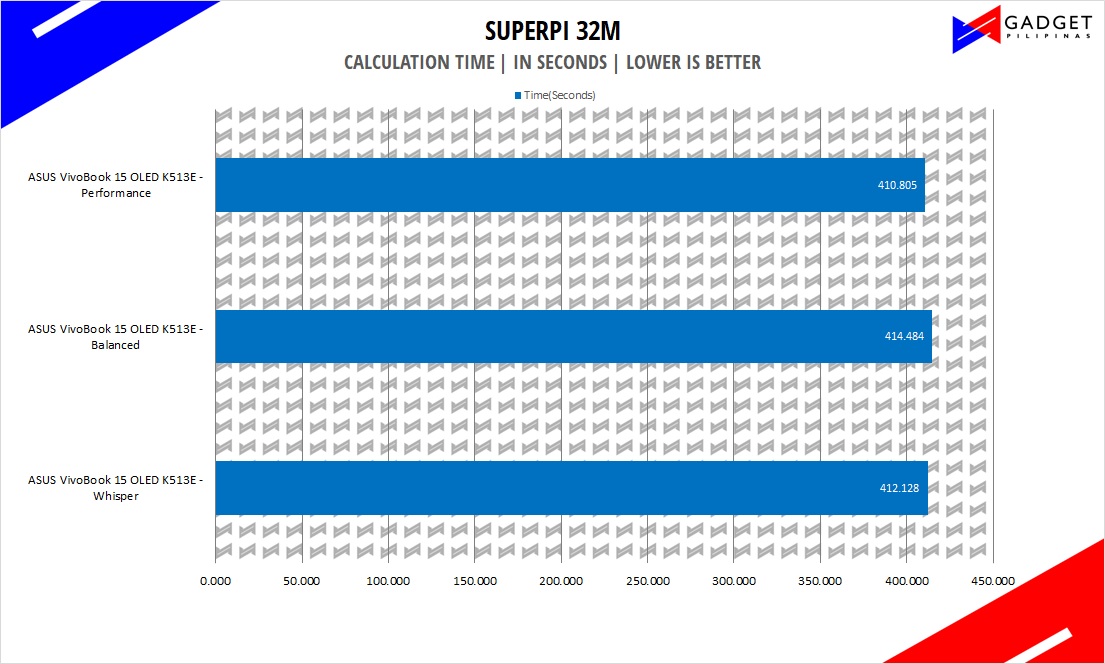 SuperPI is a single-threaded benchmark application that lets the CPU calculate Pi(π) to the nth digit. In this benchmark, we selected the Pi calculation to 32M, the highest available for the app.
SuperPI is a single-threaded benchmark application that lets the CPU calculate Pi(π) to the nth digit. In this benchmark, we selected the Pi calculation to 32M, the highest available for the app.
wPrime 1024M
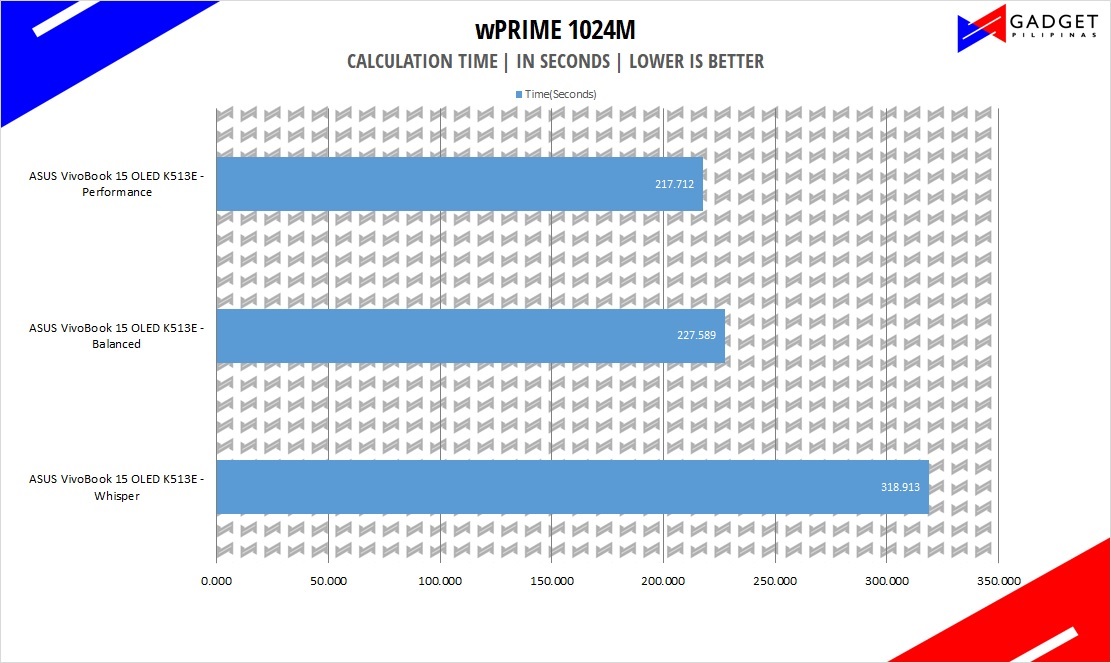 wPrime is a benchmark tool similar to SuperPI, but the former takes on finding prime numbers using Newton’s Method. The benchmark is set to calculate 1024 million prime numbers, and the performance is measured according to calculation time.
wPrime is a benchmark tool similar to SuperPI, but the former takes on finding prime numbers using Newton’s Method. The benchmark is set to calculate 1024 million prime numbers, and the performance is measured according to calculation time.
GeekBench 5
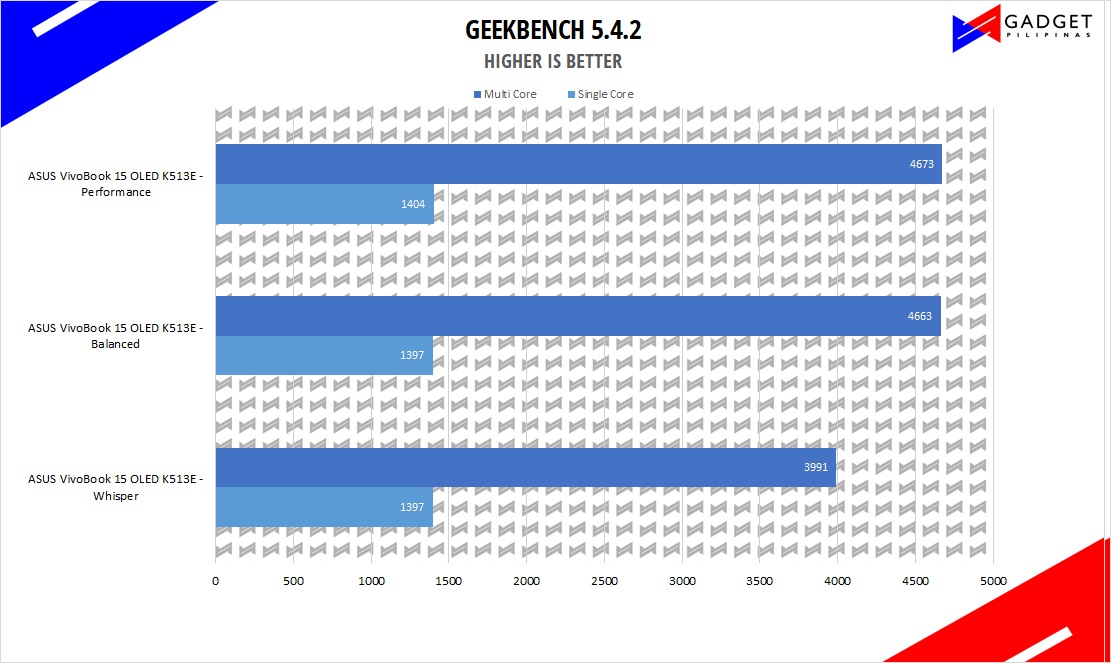 Geekbench is a multi-platform benchmark that’s used to gauge CPU performance and compare them across Windows, Mac, and Mobile. Geekbench 5 is the latest version and doesn’t rely on memory as much compared to the previous Geekbench 4, making it a great tool to measure both single-core and multi-core CPU performance.
Geekbench is a multi-platform benchmark that’s used to gauge CPU performance and compare them across Windows, Mac, and Mobile. Geekbench 5 is the latest version and doesn’t rely on memory as much compared to the previous Geekbench 4, making it a great tool to measure both single-core and multi-core CPU performance.
CINEBENCH R20 & R23
- ASUS VivoBook 15 OLED K513E Review Cinebench R20 Benchmark
- ASUS VivoBook 15 OLED K513E Review Cinebench R20 Benchmark
- ASUS VivoBook 15 OLED K513E Review Cinebench R23 Benchmark
- ASUS VivoBook 15 OLED K513E Review Cinebench R23 Benchmark
Maxon’s Cinebench benchmark is one of the most iconic benchmark applications used by reviewers and enthusiasts. The latest Cinebench R20 and R23 use the latest rendering architectures, including Intel’s Embree ray tracing technology and other advanced features from AMD and Intel that allow users to render the same scene on the same hard. Cinebench R23 uses a larger and more complex testing scene than Cinebench R20 by about 8x computational power and requires 4x the memory.
V-RAY
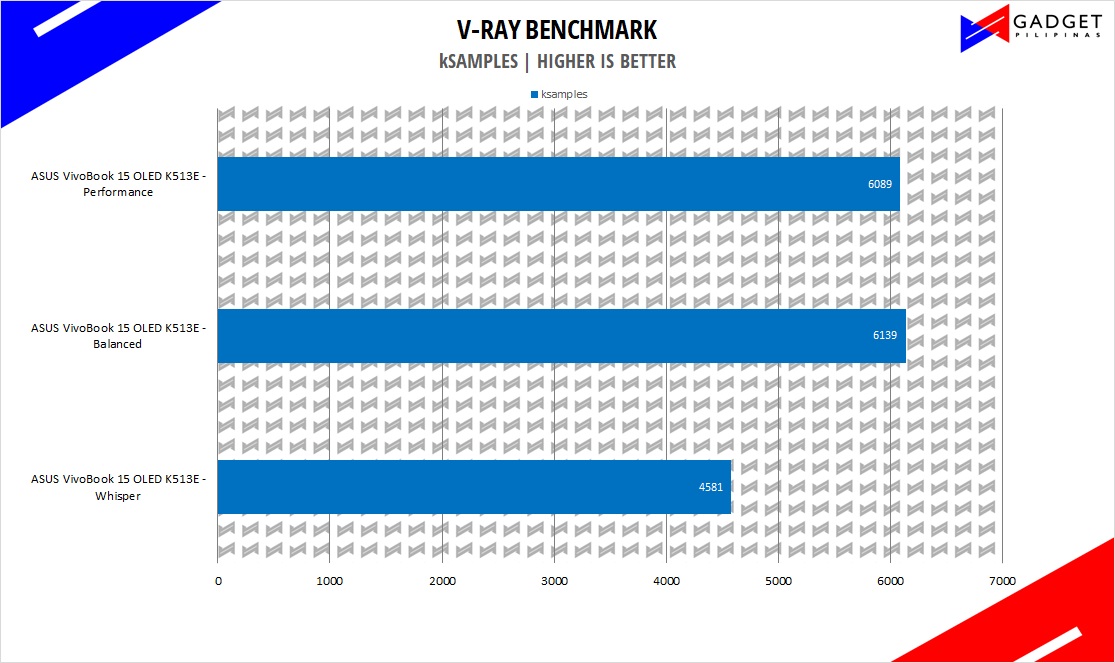 V-Ray Benchmark is a stand-alone version of V-Ray developed by Chaos Group. It is designed to test the CPU and GPU by rendering sample scenes at a fixed amount of time. V-Ray is a plug-in mostly utilized by 3D computer graphics software applications mainly for industrial design, product design, architecture, film, and video game production. V-Ray is not limited to 64-threads as it supports multi and mega-threading.
V-Ray Benchmark is a stand-alone version of V-Ray developed by Chaos Group. It is designed to test the CPU and GPU by rendering sample scenes at a fixed amount of time. V-Ray is a plug-in mostly utilized by 3D computer graphics software applications mainly for industrial design, product design, architecture, film, and video game production. V-Ray is not limited to 64-threads as it supports multi and mega-threading.
BLENDER
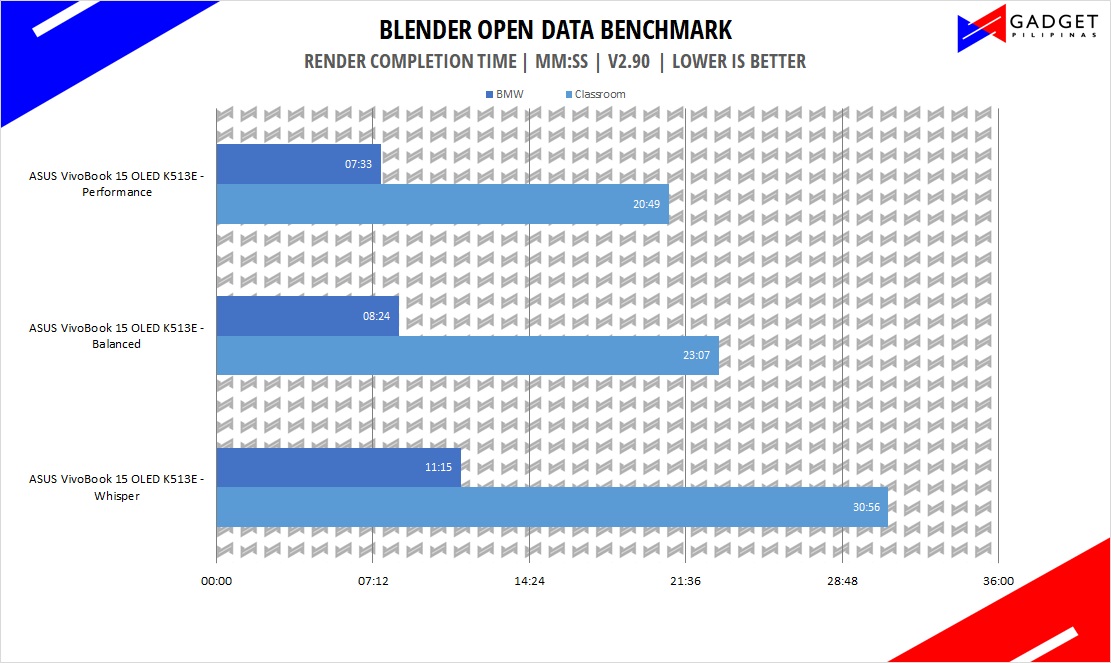 Blender is a widely used, free, open-source 3D creation suite. It supports the whole 3D pipeline process from modeling, rigging, animation, simulation, rendering, and even motion tracking. Blender has become a standard for CPU benchmarks with the BMW27 and Classroom scene most used. This prompted the company to release Blender Open Data Benchmark in 2018, a benchmark-specific version that allows users to run a preset benchmark and share the results online similar to 3D Mark.
Blender is a widely used, free, open-source 3D creation suite. It supports the whole 3D pipeline process from modeling, rigging, animation, simulation, rendering, and even motion tracking. Blender has become a standard for CPU benchmarks with the BMW27 and Classroom scene most used. This prompted the company to release Blender Open Data Benchmark in 2018, a benchmark-specific version that allows users to run a preset benchmark and share the results online similar to 3D Mark.
CORONA RENDERER
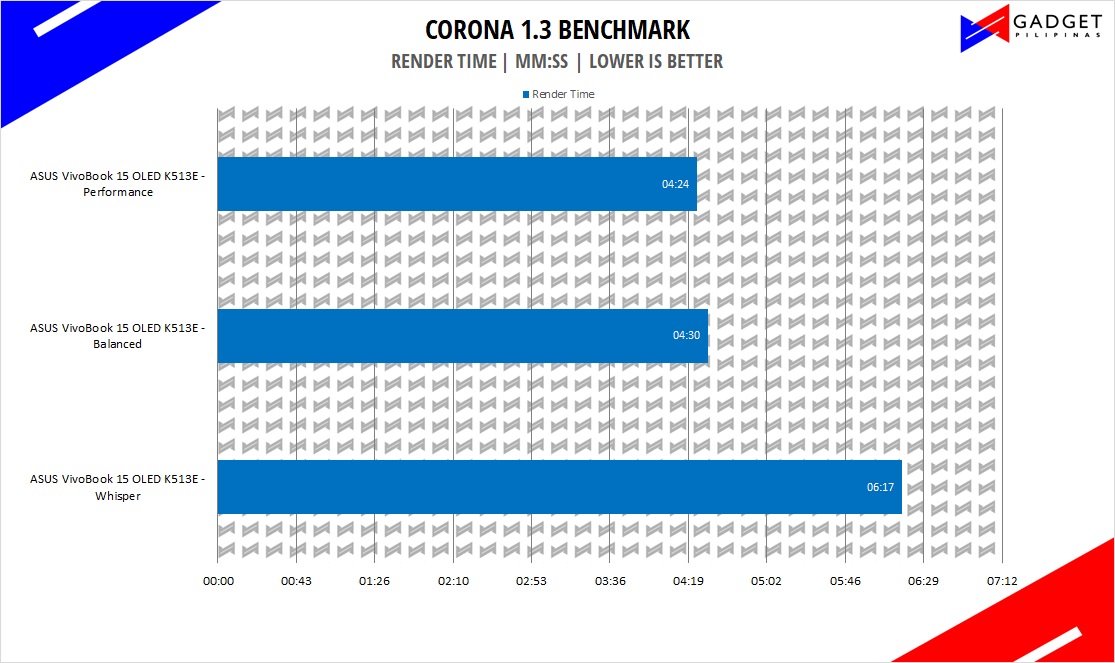 Corona Renderer is an unbiased photorealistic render available for Autodesk 3Ds Max, Maxon Cinema 4D, and as a stand-alone application. Its popularity, similar to Blender, led Chaos Group to develop a benchmark version of the app which runs using Corona Renderer 1.3. Workstation systems, especially CPUs, can utilize Corona Benchmark as up to 72 threads can be used in the benchmark, making it very suitable for CPUs with various price segments.
Corona Renderer is an unbiased photorealistic render available for Autodesk 3Ds Max, Maxon Cinema 4D, and as a stand-alone application. Its popularity, similar to Blender, led Chaos Group to develop a benchmark version of the app which runs using Corona Renderer 1.3. Workstation systems, especially CPUs, can utilize Corona Benchmark as up to 72 threads can be used in the benchmark, making it very suitable for CPUs with various price segments.
GOOGLE OCTANE 2.0
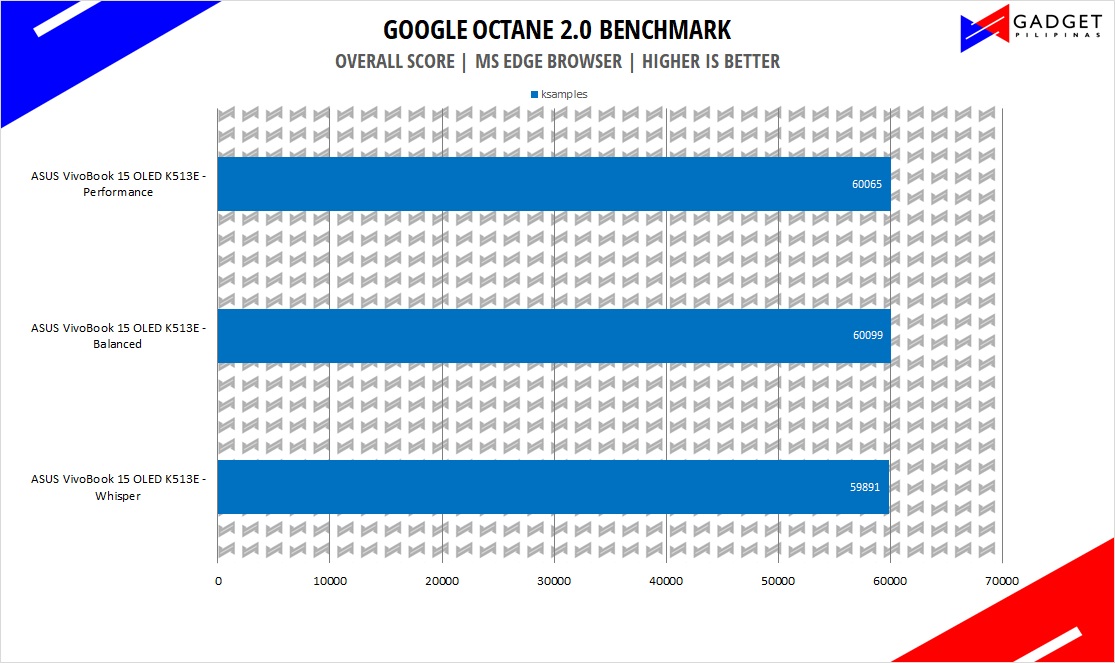 Google Octane 2.0 is a benchmark that measures a Javascript engine’s performance by running multiple tests representing different use cases of JavaScript applications. While Google Octane is retired and no longer maintained, it is still a good representation of today’s dynamic, interactive web applications. Our Google Octane 2.0 is run on Microsoft’s latest Chromium-based Edge browser.
Google Octane 2.0 is a benchmark that measures a Javascript engine’s performance by running multiple tests representing different use cases of JavaScript applications. While Google Octane is retired and no longer maintained, it is still a good representation of today’s dynamic, interactive web applications. Our Google Octane 2.0 is run on Microsoft’s latest Chromium-based Edge browser.
PCMark10
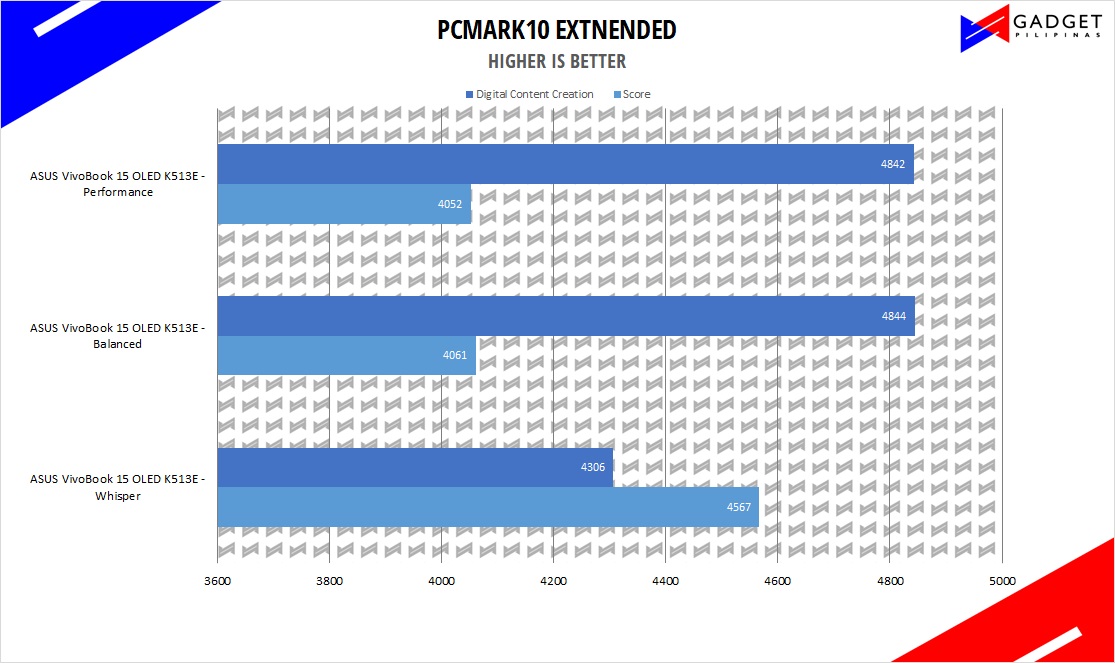 From the same developers of the popular game benchmarking tool 3DMark, PCMark 10 is a benchmarking app for measuring a whole PC’s performance. It covers a wide variety of tests to reflect common tasks performed in a modern workplace. We selected PCMark 10’s extended benchmark and reported both the overall score and Digital Content Creation Score.
From the same developers of the popular game benchmarking tool 3DMark, PCMark 10 is a benchmarking app for measuring a whole PC’s performance. It covers a wide variety of tests to reflect common tasks performed in a modern workplace. We selected PCMark 10’s extended benchmark and reported both the overall score and Digital Content Creation Score.
SSD Benchmark
- ASUS VivoBook 15 OLED K513E Review Crystal Disk Mark 16GB SSD Benchmark
- ASUS VivoBook 15 OLED K513E Review Crystal Disk Mark 16GB SSD Benchmark
- ASUS VivoBook 15 OLED K513E Review CrystalDiskMark SSD Benchmark 1GB
- ASUS VivoBook 15 OLED K513E Review CrystalDiskMark SSD Benchmark 1GB
Developed by Noriyuki Miyazaki, CrytalDiskMark is a free benchmark tool that is being used by thousands of experts. This tool measures SSD’s sequential read and write speeds. That means how fast files can be read from and written to the drive, usually measured in MB/s.
An Intel 660p 512GB PCIe Gen 4 QLC SSD is installed in the ASUS VivoBook OLED 15. Our CrystalDiskMark SSD benchmark validates the drive’s rated speed at 1,500 MB/s read and 1,000MB/s write.
ASUS VivoBook 15 OLED Temperatures and Battery Life
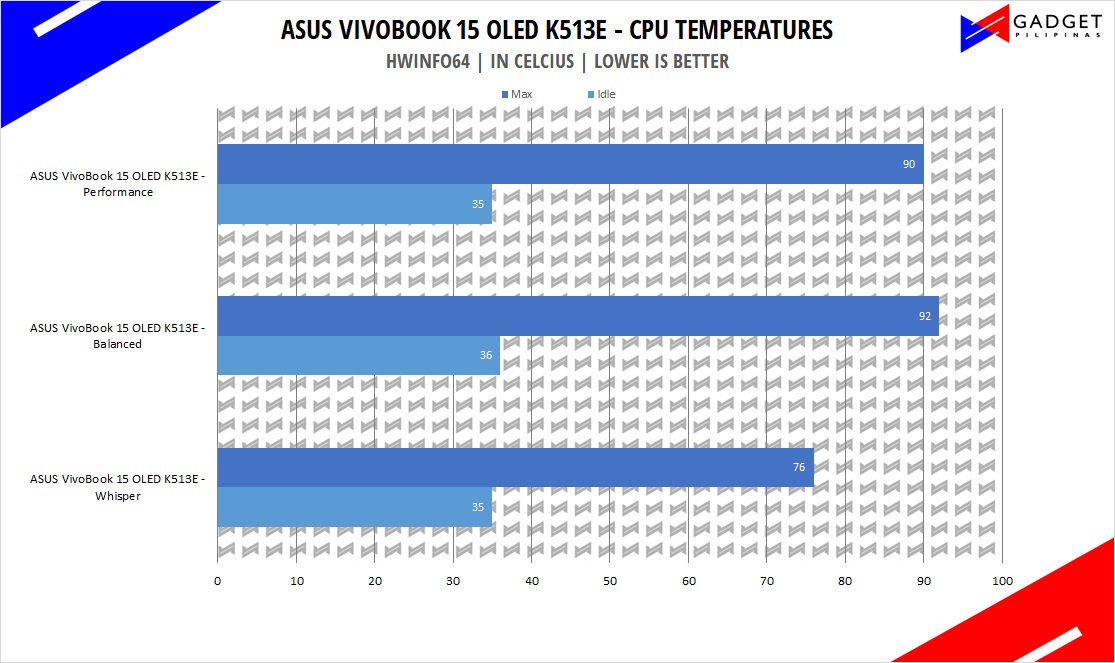 The Intel Core i5 1135G7 CPU is relatively easy to cool with a max temp of 92°C on our benchmarks which is good enough for an entry-level laptop. Idle temps are not within our preferred range considering our ambient temperature of 24°C.
The Intel Core i5 1135G7 CPU is relatively easy to cool with a max temp of 92°C on our benchmarks which is good enough for an entry-level laptop. Idle temps are not within our preferred range considering our ambient temperature of 24°C.
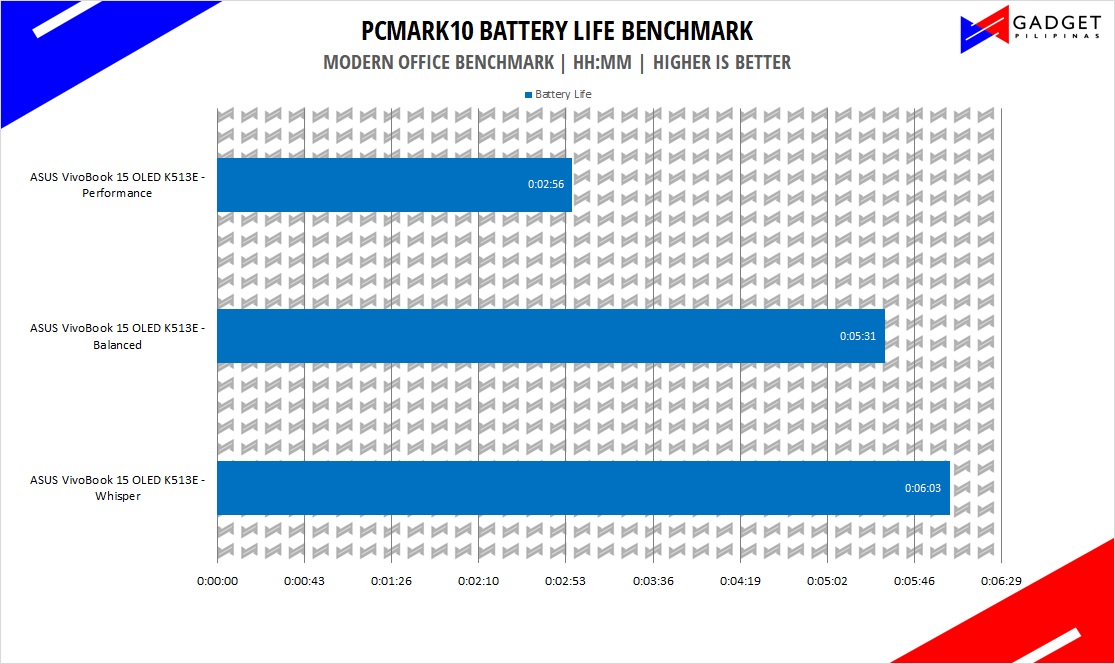 While OLED is supposed to save you battery life as the individual LEDs can turn off to reproduce blacks, the VivoBook’s 42wHr lacks the capacity to keep the laptop on for a long enough period to be productive. Sure, setting the performance setting to Whisper can double your battery life but it comes with an average performance penalty of 25 percent.
While OLED is supposed to save you battery life as the individual LEDs can turn off to reproduce blacks, the VivoBook’s 42wHr lacks the capacity to keep the laptop on for a long enough period to be productive. Sure, setting the performance setting to Whisper can double your battery life but it comes with an average performance penalty of 25 percent.
Conclusion
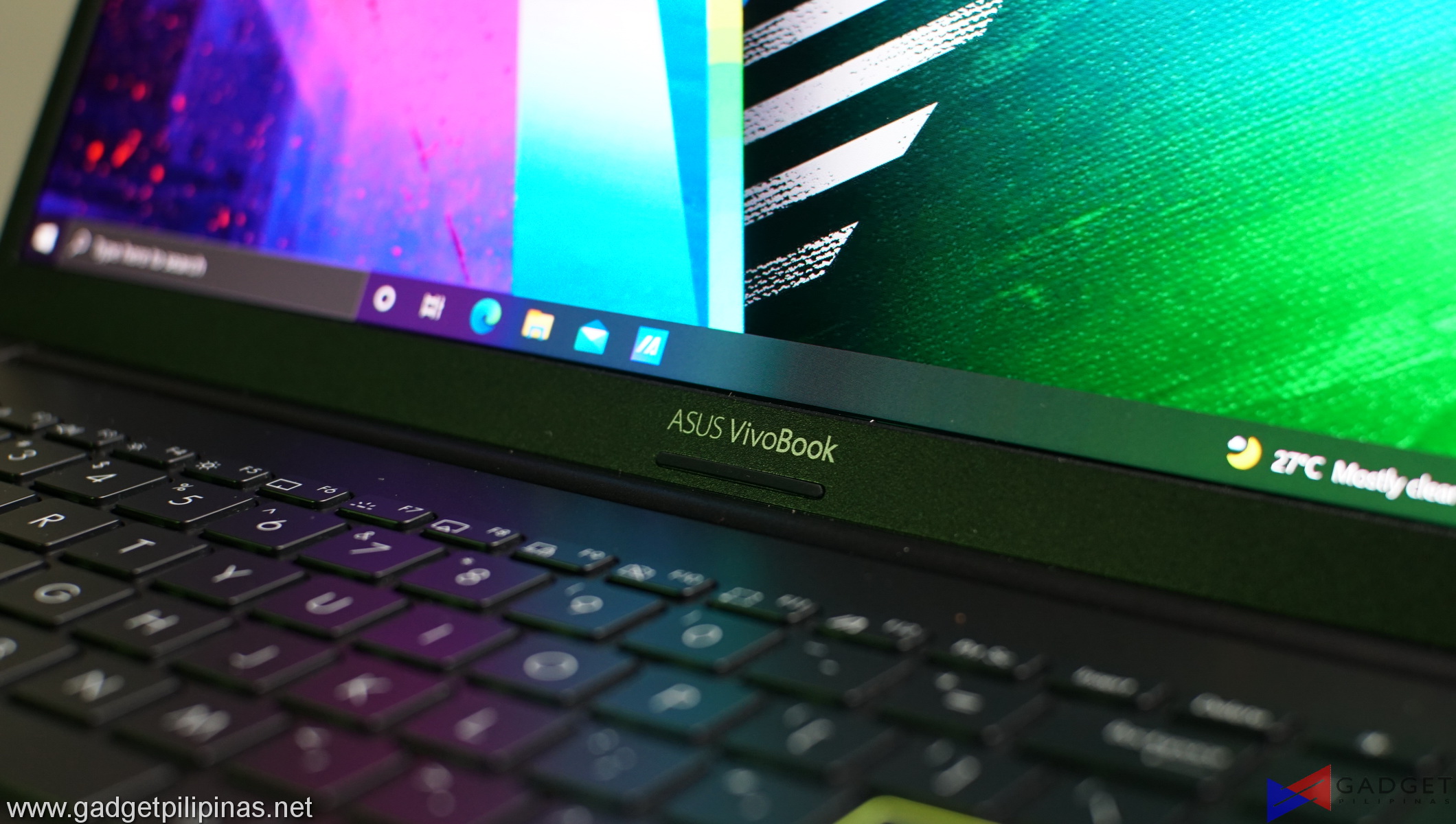 Overall, the ASUS VivoBook is your above-average entry-level laptop with stunning visuals thanks to its amazing 15.6″ 1920x1080p display. It does however have its quirks with its cramped keyboard and short battery life. Moreover, the configurations present on the ASUS VivoBook 15 OLED, especially the decked out Php 50,000 variants do not really take advantage of what the display has to offer in terms of professional video and photo editing. It would’ve been nice if ASUS had an i7 1165G7 option available as well as 16GB configurations to maximize the performance giving the VivoBook 15 OLED and the display a longer shelf life before the need to upgrade arises. If these “issues” don’t bother you that much at all, then the ASUS VivoBook 15 OLED is a great starting laptop to get yourself into photo or video editing but bear in mind the laptop’s performance limitations with the Intel Core i5 1135G7 in heavy workloads. Even if you’re a casual user who is looking for a laptop for work or entertainment, the ASUS VivoBook 15 OLED is sure to keep you stunned with its amazing visuals that simply no other laptops of this price range can match.
Overall, the ASUS VivoBook is your above-average entry-level laptop with stunning visuals thanks to its amazing 15.6″ 1920x1080p display. It does however have its quirks with its cramped keyboard and short battery life. Moreover, the configurations present on the ASUS VivoBook 15 OLED, especially the decked out Php 50,000 variants do not really take advantage of what the display has to offer in terms of professional video and photo editing. It would’ve been nice if ASUS had an i7 1165G7 option available as well as 16GB configurations to maximize the performance giving the VivoBook 15 OLED and the display a longer shelf life before the need to upgrade arises. If these “issues” don’t bother you that much at all, then the ASUS VivoBook 15 OLED is a great starting laptop to get yourself into photo or video editing but bear in mind the laptop’s performance limitations with the Intel Core i5 1135G7 in heavy workloads. Even if you’re a casual user who is looking for a laptop for work or entertainment, the ASUS VivoBook 15 OLED is sure to keep you stunned with its amazing visuals that simply no other laptops of this price range can match.

Grant is a Financial Management graduate from UST. His passion for gadgets and tech crossed him over in the industry where he could apply his knowledge as an enthusiast and in-depth analytic skills as a Finance Major. His passion allows him to earn at the same time help Gadget Pilipinas' readers in making smart, value-based decisions and purchases with his reviews and guides.

